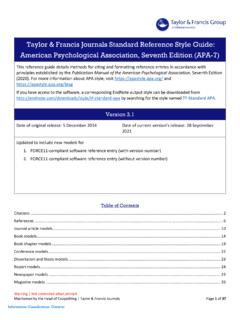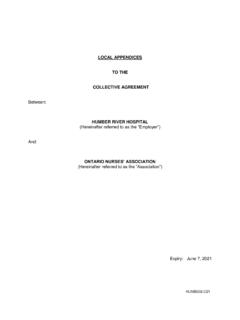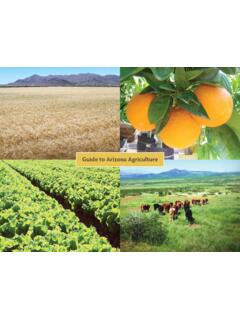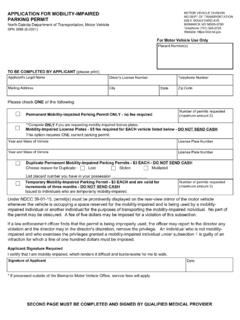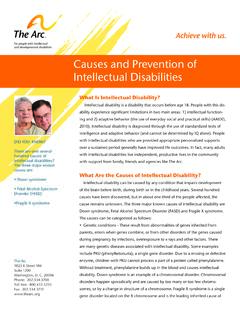Transcription of Taylor & Francis US Chicago (B) author-date style
1 Issued 2018 Warning - not controlled when printed. Maintained by Head Copyediting, Taylor & Francis Journals. Information Classification: General Contents of this guide In-text citations Reference list Book Journal Conference Thesis Unpublished work Internet Newspaper or magazine Report Personal communication Other reference types In-text citations Basic citation formats Cite a resource in the text by (1) the surname(s) of its author(s); (2) its publication year; and (3) a page number or page numbers, when necessary ( , with a direct quotation). These elements of citation can be formatted in two ways. A resource can be cited with the author surnames incorporated into the running text and the publication year and page number(s) set inside parentheses, with a comma after the year and before the page number(s): This phenomenon occurs frequently, according to Smith and Jones (2018).
2 Smith and Jones s (2018) landmark study offers valuable insights. Smith and Jones (2018, 67) consider indulgent a danger to the average child. Taylor & Francis US Chicago (B) author-date style Issued 2018 Warning - not controlled when printed. Maintained by Head Copyediting, Taylor & Francis Journals. Information Classification: General A resource can also be cited with all elements contained in parentheses and situated before terminal punctuation ( , comma, period, semicolon) in a sentence. No comma should separate the author surname(s) from the publication year. When a page number is included in the citation, a comma should appear after the publication year. If the citation appears within a parenthetical phrase, square brackets should be used to set the publication year and, if present, the page number apart from the author surname(s). This phenomenon occurs frequently (Smith and Jones 2018).
3 Several landmark studies offer valuable insights (see, especially, Smith and Jones [2018, 67] on the dangers of indulgent parenting ). One might, like some experts ( , Smith and Jones 2018, 67), consider indulgent a danger to the average child. Multiple resources cited When citing multiple resources in a parenthetical citation, two rules apply. First, separate citations by unique sets of authors with semicolons: (Jones 2018; Smith 2010) (Smith 2010; Smith and Jones 2018) Second, when citing multiple resources by the same author(s), include the surname(s) with the first resource s publication year, omit the surname(s) from subsequent citations, and separate each publication year with a comma: (Jones 2010a, 2010b, 2018) (Jones 2010a, 2010b, 2018; Smith 2010; Smith and Jones 2018) The resources can be arranged, first, alphabetically by author surnames, then, chronologically for each author set by publication year.
4 Issued 2018 Warning - not controlled when printed. Maintained by Head Copyediting, Taylor & Francis Journals. Information Classification: General Citation with a direct quotation A citation within the running text can appear before or after a direct quotation: According to Smith and Jones (2018, 67), indulgent parenting is a danger to the average child. One might consider indulgent a danger to the average child, as Smith and Jones (2018, 67) do. Parenthetical citations should appear before terminal punctuation ( , comma, period, semicolon) that follows the direct quotation: It is difficult to dispute the claim that indulgent parenting is a danger to the average child (Smith and Jones 2018, 67). It is difficult to dispute the claim that indulgent parenting is a danger to the average child (Smith and Jones 2018, 67), but researchers should entertain other opinions.
5 Longer quotations (over 100 words or six lines of manuscripts text) should be set off in a block. Parenthetical citations appear after any punctuation that ends block quotations: .. indulgent parenting is a danger to the average child. (Smith and Jones 2018, 67) Number of authors The basic formats for citations with different numbers of authors are as follows: One author: Smith (2018) or (Smith 2018) Two authors: Smith and Jones (2018) or (Smith and Jones 2018) Three authors: Smith, Jones, and Johnson (2018) or (Smith, Jones, and Johnson 2018) Four or more authors: Smith et al. (2018) or (Smith et al. 2018) Issued 2018 Warning - not controlled when printed. Maintained by Head Copyediting, Taylor & Francis Journals. Information Classification: General Use and, not an ampersand (&), to separate names in the citation of a two-author resource and a serial comma with and in the citation of a three-author resource.
6 When a resource has four or more authors, list the first author s surname followed by et al. If shortening the author listing would render the citations of two or more resources identical, list enough additional surnames before et al. in the citations to make their authorship distinguishable. Example Smith, Jones, Johnson, Rogers, and Hart (2018) AND Smith, Jones, Rogers, Johnson, and Hart (2018) BECOME Smith, Jones, Johnson, et al. (2018) and Smith, Jones, Rogers, et al. (2018) to avoid Smith et al. (2018) citations that might refer to two different resources. Authors with th e same surname If two or more authors have the same surname, include the given-name initial(s) of the authors in each citation: G. Smith (2012) and F. Smith (2008) (F. Smith 2008; G. Smith 2012) No author If a resource has no author, include a shortened form of the resource s title in lieu of an author name followed by the publication year and, as needed, a page number or page numbers.
7 Book titles should be in italics. Book: (Shortened Title of the Book 2018) Other references: ( Shortened Title of Other Reference Type 2018) Secondary source When referring to a secondary source, include as quoted in before author name in a parenthetical quotation: Smith's diary (as quoted in Jones 2012) Issued 2018 Warning - not controlled when printed. Maintained by Head Copyediting, Taylor & Francis Journals. Information Classification: General In press Use forthcoming instead of a publication year for all in-press citations: (Smith, forthcoming) Two publication years When a resource has two publication years, cite the original publication year first, in square brackets: Smith ([1890] 2018) or (Smith [1890] 2018) Tables and figures Resources cited in tables or figure legends should follow the standard format and must be included in the reference list.
8 Reference list Order Order reference entries alphabetically by author surnames. Entries without authors should be ordered alphabetically among the other entries by their title. A single-author entry precedes a multi-author entry that begins with the same surname and given name. Successive entries by two or more authors when only the first author is the same are alphabetized by co-authors last names. If reference entries have the full same author listings, arrange the entries by their years of publication, with undated works at the end. If the reference list contains two or more entries by the same author(s) with the same publication year, list them alphabetically by title of the work and add the designators a, b, c, etc. to the years in sequence: Green, M. L. 2012a. Book title. Green, M. L. 2012b. Title of book. These designators should be employed in citations: Green (2012a) Green (2012b) (Green 2012a, 2012b) Issued 2018 Warning - not controlled when printed.
9 Maintained by Head Copyediting, Taylor & Francis Journals. Information Classification: General Example of Order Jones, P., C. Lee, and R. Smith. 2017. Book chapter title. Lee, C., R. Smith, and P. Jones. 2017a. Journal article title. Lee, C., R. Smith, and P. Jones. 2017b. Title of book. Smith, R., P. Jones, and C. Lee. 2017. Journal article title. Form of author name For all authors, use initials, with periods and spaces between them, in lieu of expanded given and middle names. Include the authors surnames in full. The first author listed for a reference should appear in inverted, surname-first format, while all subsequent authors names should appear in surname-last format. Commas should separate individual author names. The word and should precede the final author name for reference entries with ten or fewer authors. If more than ten individuals authored a resource, the reference entry documenting the resource should list the first ten authors followed by et al.
10 Do not use em-dashes to replace author names if names repeat. Up to 10 Authors Format: Author, A. Z., B. Y. Author, and C. X. Author More than 10 Authors Format: Author, A. Z., B. Y. Author, C. X. Author, D. W. Author, E. V. Author, F. U. Author, G. T. Author, H. S. Author, I. R. Author, J. Q. Author, et al. ** If an organization is the author of a resource, the full name of the organization can appear in the reference, and the reference should be ordered by the full name, ignoring The if present: British Standards Institution. 2012. Issued 2018 Warning - not controlled when printed. Maintained by Head Copyediting, Taylor & Francis Journals. Information Classification: General Alternatively, the organization s abbreviation can be used in the author position of reference entry followed by the full name in parentheses. The reference would, then, be ordered by the abbreviation: BSI (British Standards Institution).



